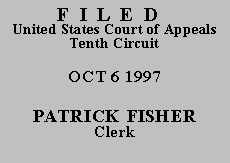

| VINCENT A. APODACA,
Petitioner-Appellant, v. JAMES FERGUSON, Warden, Wyoming State Penitentiary; WYOMING ATTORNEY GENERAL, Respondents-Appellees. |
|
Petitioner seeks leave to appeal from the district court's decision adopting the magistrate judge's report and recommendation and dismissing his petition for a writ of habeas corpus based on a claim of double jeopardy. We construe his application for a certificate of appealability as one for probable cause,(1) deny the application and dismiss the appeal.
In June 1989, while on parole from a sentence for murder, petitioner was convicted of attempted first-degree sexual assault and sentenced to eight to twenty-five years in prison. His double jeopardy claim stems from his contention that the trial judge ordered that he begin serving his sexual assault sentence immediately without determining how that conviction would affect his parole from the murder sentence. In November 1989, the parole board revoked his parole, and he returned to serving his murder sentence. That sentence is now complete, and he is back to serving his sexual assault sentence, which was made consecutive to his murder sentence. See Apodaca v. State, 891 P.2d 83, 84-85 (Wyo. 1995). Petitioner claims that his constitutional right to be free from double jeopardy was violated as follows:
Prison Officials and members of the Board of Pardons and Parole encroached upon the Judicial Powers of Judge Kalokathis [the judge who sentenced him for the attempted sexual assault] by stopping the service of the intervening sentence [for sexual assault] he imposed and (commenced) to begin running as of July 21, 1989, and place it as a detainer upon completion of the prior conviction which was never properly disposed of until November 1, 1989.
Petitioner's Br. at 8.
The double jeopardy clause protects against both multiple prosecutions and multiple punishments for the same offense. See, e.g., Witte v. United States, 515 U.S. 389, 395-96 (1995). Petitioner's double jeopardy claim involves neither of these concerns; that is, he is not being prosecuted or punished more than once for any offense. At most, petitioner is complaining about the order in which he is serving his sentences. Such sentencing matters are state law concerns that do not raise federal issues cognizable on federal habeas review. See, e.g., Bloyer v. Peters, 5 F.3d 1093, 1100 (7th Cir. 1993); Handley v. Page, 398 F.2d 351, 352 (10th Cir. 1968).
The cases petitioner relies on are irrelevant to his claim. In United States v. Villano, 816 F.2d 1448, 1450 (10th Cir. 1987), we reaffirmed that under federal criminal law an orally pronounced sentence controls over a judgment and commitment order when the two conflict. Villano did not address the order in which sentences are served. In Mack v. McCune, 551 F.2d 251, 253 (10th Cir. 1977), we stated that it has been "definitively established that the Parole Board is not required to execute a violator's warrant until such time as the intervening sentence has been served." We did not hold that a parole board is prohibited from doing so earlier. Neither of these cases supports petitioner's contention that he has a federal constitutional right to the order in which he serves his sentences.
We conclude that petitioner has failed to make a substantial showing of the denial of a federal constitutional right. Therefore, petitioner's request for a certificate of probable cause is DENIED, and the appeal is DISMISSED. The mandate shall issue forthwith.
Entered for the Court
Circuit Judge
*. This order and judgment is not binding precedent, except under the doctrines of law of the case, res judicata, and collateral estoppel. The court generally disfavors the citation of orders and judgments; nevertheless, an order and judgment may be cited under the terms and conditions of 10th Cir. R. 36.3.
1. The Supreme Court recently held that the new provisions of Chapter 153 of Title 28 of the United States Code, which includes § 2253(c) requiring certificates of appealability, added by the Antiterrorism and Effective Death Penalty Act of 1996 (AEDPA) are generally not applicable to cases filed before AEDPA's effective date, April 24, 1996. See Lindh v. Murphy, 117 S. Ct. 2059, 2068 (1997). Thus, Lennox v. Evans, 87 F.3d 431 (10th Cir. 1996), cert. denied, 117 S. Ct. 746 (1997), has been overruled to the extent that Lennox held that § 2253(c) applied to habeas petitions filed prior to AEDPA's effective date. See United States v. Kunzman, No. 96-1310, 1997 WL 602507, at *1 n.2 (10th Cir. Oct. 1, 1997) (en banc). Because the habeas petition in this case was filed prior to that date, petitioner is not subject to AEDPA, but he is subject to § 2253's previous requirement that he obtain a certificate of probable cause to appeal. Regardless of which label applies, petitioner's substantive burden is the same. As we held in Lennox, both certificates of probable cause and of appealability require that a petitioner "make a substantial showing of the denial of a federal constitutional right." 87 F.3d at 434.